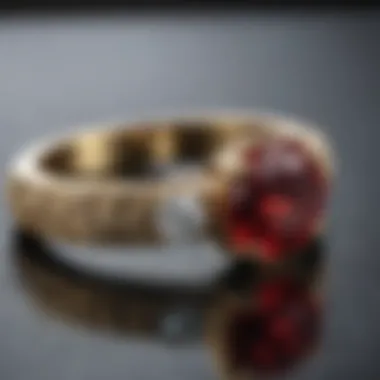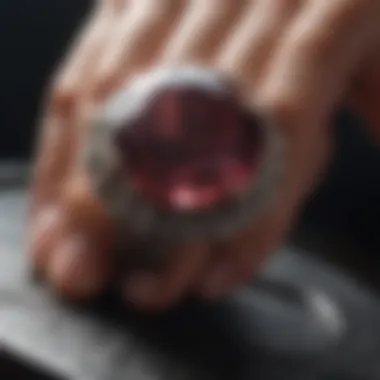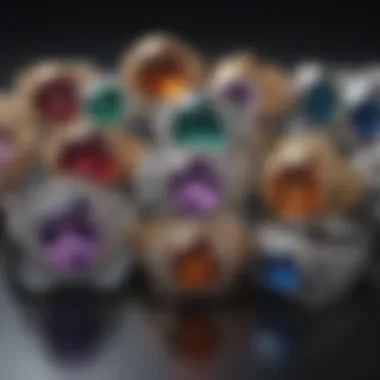Resizing a Ring: Process and Key Considerations


Intro
Resizing a ring is a common yet intricate process vital for those who experience fluctuations in their finger size. This may be relevant due to various factors such as weight loss, weight gain, or even medical conditions. Beyond mere comfort, resizing a ring often preserves the sentimental value and the aesthetics that are tied to the piece, especially when it contains gemstones.
Understanding the implications of resizing is essential, especially for gemstone enthusiasts and collectors. Not all rings can be resized easily, and the materials used in the band or the way gemstones are set can significantly affect the resizing outcome. In this guide, we will explore the factors impacting the resizing process, the methods available, how gemstone settings interact with resizing techniques, and why seeking professional assistance is crucial.
The complexities involved demand attention from both novice and seasoned jewelry owners. Whether the goal is to enhance wearability or maintain the ring's integrity, a thorough understanding of the resizing process is beneficial.
Overview of Gemstones and Minerals
History of Gemstone and Mineral Use
Gemstones have been an integral part of human civilization for millennia. Historically, they were not merely decorative but also served roles in currency, trade, and even as symbols of power. Civilizations such as the Egyptians heavily utilized lapis lazuli and turquoise in their burial artifacts, signifying both status and protection in the afterlife.
Significance in Culture and Society
Gemstones often embody rich cultural stories and significance. For instance, the diamond is associated with love and commitment, while sapphires symbolize wisdom and nobility. In many cultures, specific gemstones hold particular meanings, influencing their use in jewelry, religious artifacts, and talismans.
Gemstone Formation and Properties
Formation Process of Gemstones
The formation of gemstones occurs over extended periods under varying conditions of heat, pressure, and environmental factors. Natural processes, such as volcanic activity and sedimentation, contribute to the creation of these beautiful materials. Each gemstone's unique formation story adds to its charm and value.
Properties that Define Gemstones
Gemstones are characterized by specific physical properties that encompass:
- Hardness: Refers to the resistance to scratching, rated on the Mohs scale.
- Color: Varies widely among gemstones, influenced by chemical composition and light properties.
- Luster: Describes how light interacts with the gemstone surface.
These features play a crucial role not only in the appeal but also in determining the robustness and wearability of gemstones when incorporated into jewelry.
Classification based on Color, Hardness, and Luster
Gemstones are classified based on their characteristics. Generally, they fall into categories such as:
- Color: Blue sapphire, emerald green, ruby red.
- Hardness: Diamond (hardest), talc (softest).
- Luster: Vitreous, pearly, silky, etc.
Understanding these classifications aids in selecting gemstones that not only meet aesthetic needs but also withstand daily wear.
Types of Gemstones
Precious vs. Semi-Precious Gemstones
Traditionally, gemstones are categorized into precious and semi-precious types. Precious gemstones include diamonds, emeralds, rubies, and sapphires, largely due to their rarity and high value. On the other hand, semi-precious stones, such as aquamarine and amethyst, while beautiful, are more abundant and commonly used.
Common Gemstone Varieties
Some widely recognized gemstone varieties encompass:
- Diamond: Known for its unparalleled hardness and brilliance.
- Ruby: Celebrated for its vivid red color and rarity.
- Emerald: Famous for its rich green hue and inclusions.
- Sapphire: Available in various colors, most notably blue.
Exotic and Rare Gemstones
Certain gemstones stand out due to their scarcity or unique qualities. These include:
- Painite: Once considered the rarest mineral.
- Red Beryl: Known for its striking color and limited availability.
- Musgravite: A formidable contender in the rare gemstone realm.
Identifying and Evaluating Gemstones


Factors Affecting Gemstone Value
The value of gemstones can fluctuate depending on several factors, such as:
- Brilliance and Clarity: Higher clarity and cut lead to greater brilliance.
- Rarity: Exotic gemstones tend to fetch higher prices.
- Color Intensity: Deeper, more saturated colors are typically valued more.
Techniques for Gemstone Identification
Identifying gemstones can be accomplished through various methods, such as:
- Visual Inspection: Examining color and clarity traits.
- Gem Testing Kits: Utilizing professional tools for analysis.
- Laboratory Certification: Obtaining expert evaluations for accuracy.
Assessing Gemstone Quality
When evaluating quality, consider aspects like cuts, clarity, color, and carat weight. A well-cut stone optimizes light performance, resulting in more brilliance, while clarity determines its overall appearance when viewed under magnification.
Caring for Gemstones
Cleaning and Storing Gemstones Properly
To maintain gemstone integrity, regular cleaning and proper storage are imperative. Gentle soap and water mixtures work well for most stones, while some require specialized cleaners. Storage should be in soft pouches or boxes away from direct sunlight.
Avoiding Common Mistakes in Gemstone Care
Some common care mistakes include:
- Using Harsh Chemicals: They can damage the gemstone surface.
- Storing with Other Jewelry: Increases the risk of scratches.
Preservation Tips for Specific Gem Types
Different gemstones have their own care requirements. For instance, opals need to avoid excess moisture, while diamonds withstand more rigorous environments due to their hardness. Knowing how to properly care for each type ensures longevity and maintains their visual appeal.
Understanding these elements not only enriches the appreciation of gemstones but also informs decisions about resizing rings with integrated gemstones. As resizing can affect the durability and placement of gems, awareness of these factors is crucial for anyone engaged in jewelry ownership or design.
Preamble to Ring Resizing
Ring resizing is a crucial process that addresses the necessity of fitting rings appropriately on the wearer’s finger. The significance of this topic extends far beyond mere aesthetics; it is closely tied to comfort, personal expression, and the integrity of the jewelry itself. As individuals experience changes in finger size—whether due to weight fluctuations, health conditions, or lifestyle changes—their jewelry must adapt accordingly.
Understanding the resizing process can make a significant difference in ensuring that ownership of a beloved ring does not lead to discomfort or potential loss. The considerations that arise during resizing are multifaceted, involving not just the mechanics of adjusting size but also the implications for the materials, settings, and overall design. The methods and tools involved reflect a deep respect for the artistry of jewelry making.
By delving into ring resizing, this article aims to equip readers with the knowledge to make informed decisions. We will explore various methods available, factors influencing the choice of techniques, and the potential risks involved. In the following sections, we aim to provide a thorough understanding of the resizing process and its importance for those who appreciate fine jewelry, gemstones, and intricate designs.
Understanding the Need for Resizing
The need for resizing a ring can arise from several circumstances. One of the primary reasons is the natural changes that occur in the body over time. Factors like aging, weight gain or loss, and pregnancy can influence finger size considerably. People often find their rings either tight or loose, leading to discomfort and the risk of losing the ring. In addition, certain activities might cause finger swelling, resulting in a fluctuating fit.
Another aspect worth noting is the sentimental value carried by many rings. Rings often symbolize important milestones—such as engagements or anniversaries. Many individuals wish to make these special pieces fit comfortably, preserving their emotional connection without sacrificing usability. Moreover, resizing a ring not only enhances wearability but also maintains its aesthetic value, ensuring that the piece remains an integral part of the wearer’s life.
Common Reasons for Ring Resizing
Several common scenarios necessitate the resizing of rings:
- Weight Changes: Variations in body weight can lead to the need for adjustments in ring size. Significant weight loss can render a ring loose, while weight gain may cause it to fit tightly.
- Life Changes: Events like pregnancy can lead to body changes that influence finger dimensions, causing rings to fit differently throughout various stages.
- Comfort Issues: A ring that does not fit well can be uncomfortable during daily activities, prompting many to seek resizing to enhance wearability.
- Acquisition of Heirlooms: Inheriting rings from family members often means these pieces require resizing to suit the new wearer’s finger size.
- Fashion Preferences: Personal style trends may shift, influencing the desired fit or appearance of a ring.
Ultimately, resizing is an essential service in the jewelry industry, allowing individuals to maintain their cherished pieces while adapting to their evolving lives.
The Resizing Process
The process of resizing a ring is crucial for maintaining both its wearability and overall aesthetic value. Rings may become too loose or too tight due to various reasons, such as weight loss or gain, temperature fluctuations, and natural aging. Understanding how to resize a ring properly helps ensure that it remains a cherished piece of jewelry over time. Moreover, an appropriate resizing method can prevent damage to both the ring and any gemstones it may contain.


Types of Resizing Methods
Stretching Method
The stretching method is often favored for resizing rings that require only a slight increase in size. In this technique, the metal is physically stretched, allowing for a slight expansion of the band. This method is popular due to its simplicity and non-invasive nature.
A key characteristic of this method is that it leaves the design and integrity of the ring mostly intact. Additionally, it is suitable for softer metals like gold or silver. However, there are limitations; not all rings, particularly those with intricate designs or certain types of gemstones, can be effectively resized using this method.
Advantages of the stretching method include lower costs and quicker turnaround times, while disadvantages may involve potential stress-induced damage to the ring.
Cut and Resize Method
The cut and resize method is more commonly utilized when a ring needs significant size adjustments. This approach involves cutting the band and removing a portion of it, then reconnecting the ends to secure the desired fit.
This method allows for more extensive resizing compared to others. A unique feature of the cut and resize method is its versatility; it can be applied to rings made from various metals and designs. Nevertheless, this approach may sometimes alter the original design or finish of the band and can be more time-consuming and costly than other methods.
Soldering Technique
Soldering is a well-established technique often used in professional jewelry resizing. By adding or removing material, soldering provides a solid method for ring resizing. This is particularly useful for complicated designs or rings that include precious stones.
The primary advantage of soldering is the ability to maintain the original structure of the ring while providing a secure fit. One particular feature of this technique is that it can be applied to both increasing and decreasing the ring size effectively. On the flip side, soldering can require specialized skills and tools, which can lead to higher costs.
Factors Influencing the Choice of Method
When deciding which resizing method to use, several key factors come into play. One crucial factor is the type of metal from which the ring is made, as different metals respond differently to resizing techniques. For example, platinum requires more skill to resize compared to gold or silver.
Another important factor is the design of the ring. Rings with intricate settings or valuable gemstones may necessitate more careful handling and specific techniques to avoid damage. Additionally, the degree of resizing needed will also inform the choice of method, as some approaches are better suited for minor adjustments while others can accommodate significant changes.
"Selecting the right resizing method hinges upon understanding the unique characteristics of both the ring and the wearer's needs."
By considering these factors, individuals can make informed decisions that maintain the integrity of their cherished jewelry.
Considerations Before Resizing
Before deciding to resize a ring, several factors must be taken into account. Resizing can affect the ring's overall harmony, appearance, and functionality. Understanding these considerations helps maintain the integrity of the ring while ensuring a comfortable fit. The choice of material, the presence of gemstones, and potential resizing limitations play crucial roles in this process.
Assessing the Ring's Material
Gold
Gold is a traditional and widely recognized material for rings. Its malleability allows for easy adjustments when resizing. One key characteristic of gold is its alloy composition, often mixed with other metals like copper or silver to enhance durability. This quality makes gold a popular choice among many people. The unique feature of gold rings is their ability to be resized multiple times without compromising structural integrity, although this can vary depending on the alloy mixture. However, it might require careful consideration to keep the finish and polish intact, which can be a minor drawback.
Platinum
Platinum offers a modern take on ring material. Known for its density and durability, platinum is less likely to warp than gold during the resizing process. This attributes to its enduring quality, making it a wealthy choice for engagement and wedding rings. Platinum's unique feature is its hypoallergenic properties, ensuring it is safe for sensitive skin. While the metal is more expensive than gold, its longevity and minimalist appearance can justify the cost. The downside includes that resizing can be more challenging due to the metal's hardness and density, requiring specialized tools and skills.
Silver
Silver is often seen as a more affordable alternative that still holds beauty and elegance. It is softer than gold and platinum, which means resizing can be performed with more ease. The primary characteristic of silver rings is their bright, shiny finish that can be easily polished or re-plated if tarnished. The uniqueness of silver is its versatility in design, making it appealing for custom or artistic rings. However, its softness can lead to scratching, and rings may not hold their shape as well as those made from gold or platinum. Therefore, careful consideration is advised when resizing to avoid diminishing the ring's aesthetics.
Gems and Settings Considerations
Prong Settings
Prong settings are a staple in jewelry design, particularly for engagement rings. They consist of metal claws that keep the gem in place, allowing for maximum light exposure. This feature enhances the gem's brilliance, making it a favored choice for many. Considerations arise during resizing, as the prongs may need to be adjusted to ensure the setting remains secure. However, if not done correctly, resizing can shift the gemstone, potentially leading to loosening or loss.
Bezel Settings
Bezel settings encase the gemstone with a metal rim. This design provides excellent security for the gem and can be easier to resize compared to prong settings. Its unique feature is that it offers a sleek and modern look, appealing to those who prefer simplicity. While resizing a bezel set ring may require less delicate handling than prong settings, the metal may need to be reshaped to fit properly. This process carries the risk of damaging the aesthetic appeal if not executed carefully.


Tension Settings
Tension settings create a distinctive effect, holding the gemstone in place by the compression of the band itself. This method has gained popularity due to its contemporary appeal and innovative design. One key characteristic is that it maximizes light exposure, resembling a gem floating within the band. Tension setting rings can be tricky to resize since altering the band can directly affect the tension and potentially compromise the gemstone's security. This can present significant challenges in maintaining the ring’s integrity and beauty.
Potential Limitations of Resizing
Resizing a ring may sometimes come with limitations. For example, rings with intricate designs or patterns may lose their unique aesthetics when resized. Additionally, the type and quality of material can limit how much a ring can be resized. A general rule of thumb lies in the size adjustment, as most rings can only be resized up or down by two sizes without risking damage. Furthermore, the presence of diamonds or other gemstones can complicate the resizing process. Not only can their placement be affected, but they may also sustain damage if not handled properly. When all these considerations are weighed, it becomes clear that the resizing process requires careful consideration to achieve a satisfactory outcome without compromising the jewelry's essence.
"Understanding the properties of the ring’s material and setting is crucial for a successful resizing process. Each type presents its unique challenges and benefits."
Understanding these factors ensures that all elements work together harmoniously during the resizing process, maintaining the ring's balance and style.
Professional Assistance vs. DIY
The decision to resize a ring often leads to a fundamental choice between seeking professional help or attempting to execute the task independently. Each option carries its own set of benefits and challenges.
Engaging a skilled jeweler for resizing ensures expert guidance through various considerations including the ring's material, gemstone settings, and potential complications. Professional jewelers possess specialized tools and experience that enable them to execute alterations accurately, minimizing the risk of damage. Moreover, they can provide valuable advice on suitable resizing methods based on the specific ring and its unique features. This insight is crucial for maintaining the integrity of the ring while achieving a comfortable fit.
Conversely, some individuals may consider DIY methods for resizing rings as a cost-saving measure. While there are numerous resources and tutorials available, these often lack the thoroughness of professional education. Understanding when to opt for expert help is essential for any ring owner.
Benefits of Professional Resizing
- Expert Knowledge: Professional jewelers have the training to assess both the ring and the person's needs. Their knowledge helps in selecting the best resizing technique, ensuring the ring retains its value.
- Quality Assurance: Professionals guarantee a standard of work that is often unattainable for DIY attempts. They can ensure that the resizing does not compromise the ring's design or its settings.
- Preservation of Gemstones: Resizing a ring involves considerations about gemstones. Jewelers can carefully assess settings like prong or bezel to avoid damage during the resizing process.
- Comprehensive Services: Many jewelers also offer cleaning and assessment during resizing. This holistic approach ensures that the ring looks its best after the alteration.
"Engaging a professional not only secures the longevity of your ring but also preserves its radiant aesthetic."
Challenges of DIY Resizing
- Risk of Damage: Without the right tools or skills, resizing can lead to damaging the ring or gemstone, leading to costly repairs.
- Limited Techniques: DIY methods often utilize basic tools and lack the effectiveness required for specific materials or settings.
- Inconsistent Results: Results from DIY attempts can vary significantly. A poorly executed resizing may lead to an uncomfortable fit or misalignment of gemstones.
- Time and Effort: The learning curve for DIY projects can require considerable time. This effort might not be worthwhile, especially compared to professional efficiency.
Post-Resizing Care
Post-resizing care is crucial for maintaining the integrity and appearance of a resized ring. The resizing process alters the ring's physical properties, possibly affecting its overall feel and look. Proper care ensures that the ring remains comfortable to wear and retains its beauty for years to come.
Cleaning and Maintenance Tips
Cleaning a resized ring requires special attention, especially in the initial period after resizing. Here are some tips:
- Use gentle cleaners: Avoid harsh chemicals. Instead, opt for mild soap mixed with warm water. This will help keep the ring clean without compromising materials or gemstones.
- Soft cloth: Always use a soft, lint-free cloth to dry the ring after cleaning. This prevents any potential scratches on the surface.
- Avoid abrasive materials: Materials like rough sponges and commercial cleaners can damage the surface finish. Stick to softer solutions that preserve shine.
- Regular maintenance: Schedule periodic professional cleaning. Jewelers have specialized tools and cleaners to keep your ring in excellent condition.
- Avoid extreme conditions: Take off your ring when swimming, exercising, or doing household chores. This minimizes the risk of damage and maintains its integrity.
Monitoring Ring Fit Over Time
After resizing, it's important to monitor how the ring fits over time. Needles can fluctuate due to various factors including temperature and daily activities. Here are key points to consider:
- Regular checks: Make it a habit to check if the ring fits comfortably. If it feels tight or loose, consider revisiting a jeweler.
- Skin changes: Hormonal changes, weight fluctuations, and even seasonal changes can affect finger size. Be aware of how your body changes.
- Professional advice: If you notice any issues, do not hesitate to consult a professional. They can recommend solutions or, if necessary, do further adjustments.
- Note changes in the setting: Pay attention if any settings appear loose. Loose stones may require immediate professional attention to avoid loss.
"Proper post-resizing care not only enhances the lifespan of your ring but also preserves its aesthetic appeal."
In summary, both cleaning and monitoring the fit are essential aspects of post-resizing care. Taking simple precautions can significantly extend the life of a resized ring and maintain its beauty.
Epilogue
In the discussion of resizing a ring, it is essential to recognize its significance for individuals who may experience changes in finger size. This not only restores comfort but also maintains the aesthetic integrity of the piece. Resizing can reinstate a ring's rightful place in your accessory collection, ensuring it remains a cherished belonging rather than an uncomfortable reminder of a bygone fit.
Restoring Comfort and Style
When a ring no longer fits properly, it can create discomfort and even lead to the loss of the piece. A well-executed resizing process can significantly enhance the wearability of your jewelry. Comfort is paramount; a ring that is too tight can create an uncomfortable situation, while one that is too loose may slip off and become lost.
The style of the ring often must be preserved during resizing. Professional jewelers understand the importance of keeping the design intact while adjusting the size. They consider factors like the ring’s metal type, gemstone settings, and overall design. Ensuring that a resized ring maintains its style is crucial not only for aesthetic reasons but also for the sentiment it holds.
Final Thoughts on Ring Resizing
In summary, resizing a ring is a process that requires careful consideration and attention to detail. Whether it involves professional help or a DIY approach, being informed about the materials and methods can lead to a successful outcome.
The implications of the resizing extend beyond just the physical change in size. There are emotional and sentimental values tied to rings, particularly if they are gifts or family heirlooms. Thus, maintaining these rings in a wearable condition is essential.
Ultimately, resizing can provide both a functional and emotional solution. By understanding the process and the considerations involved, individuals can approach resizing confidently, ensuring that their cherished pieces continue to bring joy without sacrificing comfort.







